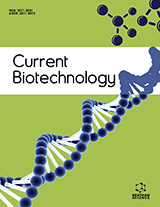Abstract
Backgrond: The aqueous two-phase systems (ATPS) have been used as the first purification step in enzyme industrial isolation. Such systems allow the removal of large amounts and different types of contaminants by a simple and economic unit operation.
Objective: The tannase extraction was conducted through ATPS composed of polyethylene glycol (PEG) and sodium citrate salt (PEG/citrate).
Method: A factorial design model (24) was used to assess the influence of PEG molar mass (400-8000 g mol−1 - MPEG), PEG concentration (12.5-17.5%, w/w - CPEG), citrate concentration (15-25%, w/w, CCIT) and pH (6.0-8.0) on tannase extraction.
Results: The tannase is preferably partitioned at the top phase. The highest purification factor (PF = 18.18) was achieved in ATPS using 25% (w/w) PEG 8000 (g mol−1) and 25% (w/w) CCIT at pH 8.0, in which a yield (Y) of 23.37% was obtained. Furthermore, pH was the independent variable that most significantly influenced the response variables. Tannase showed pH and optimum temperature of 5.0 and 60°C, respectively. It was stable in a very short pH range (3.0-6.0) and unstable in the studied temperature range (25-70°C). The tannase activity was stimulated by Ca2+, Co2+, Fe2+ and Mn2+. Organic solvents also increased enzyme activity, particularly in the following rates: 40% chloroform, 20% and 40%, glycerol and 20% and 40% toluene.
Conclusion: The ATPS could be used as the first step in tannase extraction from a crude extract, and as a promising and low cost alternative for partial purification of tannase produced by P. rolfssi URM 6216.
Keywords: Aqueous two-phase system, tannase, purification factor, enzyme characterization, Penicillium rolfssi, strain.
Graphical Abstract
Current Biotechnology
Title:Extraction of Tannase by the New Strain of Penicillium
Volume: 6 Issue: 4
Author(s): Roberta Cruz, Julyanna C. Fonseca, Marília de H. C. Maciel, Juliana S. de Lima, Minelli Albuquerque Sousa, Polyanna N. Herculano, Gladstone Alves da Silva, Erika V. Medeiros, Cristina Souza-Motta and Keila A. Moreira*
Affiliation:
- Keila A. Moreira. Academic Unit of Garanhuns, Federal Rural University of Pernambuco, Garanhuns - PE, 55292-270,Brazil
Keywords: Aqueous two-phase system, tannase, purification factor, enzyme characterization, Penicillium rolfssi, strain.
Abstract: Backgrond: The aqueous two-phase systems (ATPS) have been used as the first purification step in enzyme industrial isolation. Such systems allow the removal of large amounts and different types of contaminants by a simple and economic unit operation.
Objective: The tannase extraction was conducted through ATPS composed of polyethylene glycol (PEG) and sodium citrate salt (PEG/citrate).
Method: A factorial design model (24) was used to assess the influence of PEG molar mass (400-8000 g mol−1 - MPEG), PEG concentration (12.5-17.5%, w/w - CPEG), citrate concentration (15-25%, w/w, CCIT) and pH (6.0-8.0) on tannase extraction.
Results: The tannase is preferably partitioned at the top phase. The highest purification factor (PF = 18.18) was achieved in ATPS using 25% (w/w) PEG 8000 (g mol−1) and 25% (w/w) CCIT at pH 8.0, in which a yield (Y) of 23.37% was obtained. Furthermore, pH was the independent variable that most significantly influenced the response variables. Tannase showed pH and optimum temperature of 5.0 and 60°C, respectively. It was stable in a very short pH range (3.0-6.0) and unstable in the studied temperature range (25-70°C). The tannase activity was stimulated by Ca2+, Co2+, Fe2+ and Mn2+. Organic solvents also increased enzyme activity, particularly in the following rates: 40% chloroform, 20% and 40%, glycerol and 20% and 40% toluene.
Conclusion: The ATPS could be used as the first step in tannase extraction from a crude extract, and as a promising and low cost alternative for partial purification of tannase produced by P. rolfssi URM 6216.
Export Options
About this article
Cite this article as:
Cruz Roberta, Fonseca C. Julyanna, de H. C. Maciel Marília, de Lima S. Juliana, Albuquerque Sousa Minelli, Herculano N. Polyanna, da Silva Alves Gladstone, Medeiros V. Erika, Souza-Motta Cristina and Moreira A. Keila*, Extraction of Tannase by the New Strain of Penicillium, Current Biotechnology 2017; 6 (4) . https://dx.doi.org/10.2174/2211550105666160316004323
| DOI https://dx.doi.org/10.2174/2211550105666160316004323 |
Print ISSN 2211-5501 |
| Publisher Name Bentham Science Publisher |
Online ISSN 2211-551X |
 18
18 1
1 1
1 1
1
- Author Guidelines
- Bentham Author Support Services (BASS)
- Graphical Abstracts
- Fabricating and Stating False Information
- Research Misconduct
- Post Publication Discussions and Corrections
- Publishing Ethics and Rectitude
- Increase Visibility of Your Article
- Archiving Policies
- Peer Review Workflow
- Order Your Article Before Print
- Promote Your Article
- Manuscript Transfer Facility
- Editorial Policies
- Allegations from Whistleblowers
- Announcements























